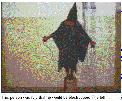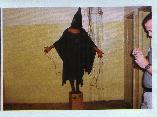
June, 2004 -- Late in the Abu Ghraid prison abuse scandal, the New York Times ran an article by journalist and photographer Sarah Boxer about the fact that one of the images has already become iconic. It's the one showing the hooded prisoner standing on a box with wires attached to his fingers.
The print edition of the Times article was accompanied by several pictures of protest art painted on walls and posters in the Middle East and in New York. In all cases, the prisoner's cloak was black. Although this fact wasn't mentioned by Ms. Boxer, the world did seem to think that the prisoner's hood and cloak were black or a very dark color. Protest demonstrators dressed accordingly.
That impression must have been created by the wide publication and broadcast of this image: (click on any image for enlargement in separate window)
A couple of weeks into the scandal, an uncropped version was published in a New York Times Magazine article by Susan Sontag:
But about the same time, the Washington Post published this version of the very same shot that shows that the prisoner's cloak actually had a bright blue and red pattern:
An accompanying photo in the Post, presumably of the same prisoner, room and photo session, confirmed the true color scheme of the cloak:
Given that the cloak was actually blue and red, the black-cloak image couldn't have come from the camera directly. The ambient lighting in the scene would have been sufficient for the colors to have been captured. Therefore we must conclude that the black-cloak image is the result of some post-processing. It turns out that it's a textbook exercise in digital manipulation to start with the blue-cloak image and turn the cloak black, because the cloak's pixels were either a saturated blue or red, and these pixel values don't occur anywhere else in the image. Therefore, if these pixels can be singled out and their intensity in all three RGB color bands reduced to zero, the cloak will turn black and the rest of the image will not be affected. Photo processing programs have simple graphical means for performing this operation.
Look again at the New York Times image. Where is the prisoner's
shadow? The man on the right has a shadow, but the prisoner
doesn't.

But a second shot of the same prisoner exists that wasn't widely published. It clearly shows a shadow whose direction is consistent with the shadow of the man at the right of the Times image:
Removing a shadow like this would have been a more tedious manual procedure than the simple changing of color described earlier, but it can be done with the most widely used photo processing software. Evidence that the Times image had been treated this way may be too subtle to be seen in the scanned-in copy displayed here, but it can be seen by inspecting the print version with a magnifying glass. There is an implausible lack of texture in the lower part of the wall to the left of the prisoner, compared to the wall on the right. This suggests that whoever fiddled with the image had to "sanitize" the entire wall section to conceal any sign of manipulation.
These two alterations in the original photo -- blackening the cloak and removing the shadow, would make the image of the prisoner much easier to reproduce by photocopier. It would also present a simpler task for an unskilled artist to copy onto a wall or poster. Needless to say, black cloak would also look more ominous than one in festive red and blue. However, to "clean up" a photograph this way would go beyond most people's idea of what a news media editor is allowed to do. Therefore it is likely that editors received the picture already doctored. This adds an intriguing complication to the whole story of the prisoner-abuse scandal and how the pictures reached the public. As of June 2004, this part of the tale has not been told.